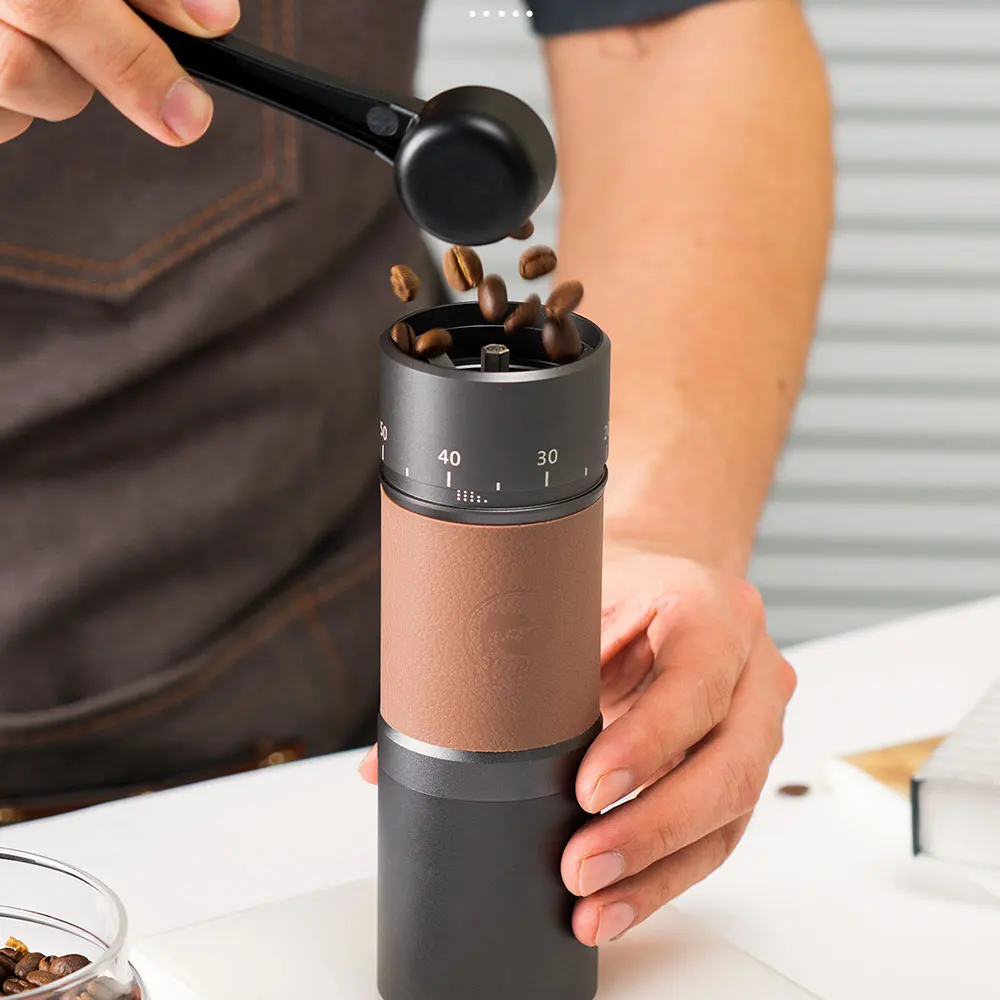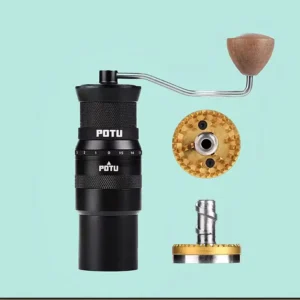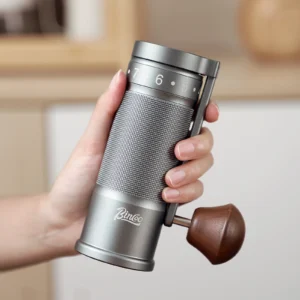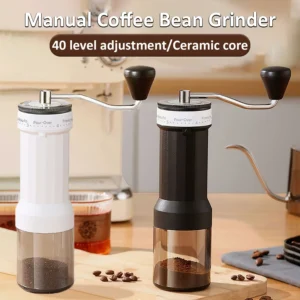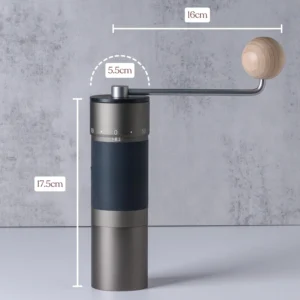Understanding Ergonomics in Coffee Grinders: The Foundation of Comfort
When it comes to manual coffee grinders, ergonomics refers to the design features that make the grinding process more comfortable, less physically demanding, and more efficient. An ergonomic coffee grinder is thoughtfully designed to reduce strain on your hands, wrists, and arms while providing a stable and enjoyable grinding experience.
Why does this matter? For coffee enthusiasts, grinding beans is a daily ritual. This repetitive motion, performed regularly over months and years, can lead to discomfort or even pain if your grinder isn’t designed with your body in mind. The right ergonomic design can transform what might be a tedious chore into a pleasant part of your coffee routine.
Ergonomics in coffee grinders isn’t just about comfort—it’s about finding the perfect balance between ease of use and grind performance. After all, the most comfortable grinder in the world wouldn’t be worth much if it produced inconsistent grounds.
Different users have different ergonomic needs. Someone with arthritis or limited hand strength will benefit enormously from thoughtful ergonomic design features. Even for those without physical limitations, a well-designed grinder makes the difference between looking forward to your morning grinding ritual and dreading it.
Coffee grinder design has evolved significantly, with manufacturers increasingly recognizing that precision grind settings depend not just on mechanical components but also on the user’s ability to operate the grinder comfortably and consistently.
The Impact of Ergonomic Design on Your Coffee Experience
An ergonomic coffee grinder doesn’t just feel better in your hands—it transforms your entire coffee experience in several important ways:
- Reduced Physical Strain: Well-designed grinders minimize the effort required to turn the handle, resulting in less fatigue during grinding sessions.
- Prevention of Injuries: Daily grinding with a poorly designed grinder can lead to repetitive stress injuries over time. Ergonomic models help prevent these issues before they start.
- Improved Consistency: When you’re comfortable while grinding, you maintain a more consistent speed and pressure, which directly translates to more uniform coffee grounds.
- Enhanced Enjoyment: A comfortable grinding experience makes the ritual more pleasant, allowing you to focus on the aromas and sensations rather than discomfort.
- Accessibility: Good ergonomics make manual grinding possible for people with varying degrees of hand strength and dexterity.
- Sustainability of Habit: When grinding isn’t physically taxing, you’re more likely to maintain your manual grinding habit rather than reverting to pre-ground coffee or electric alternatives.
The importance of ergonomics becomes even more apparent when you consider the time involved in grinding. Preparing enough coffee for a pour-over might take 15-30 seconds of continuous grinding, while espresso can require 30-60 seconds or more due to the finer grind needed. Without proper ergonomics, users often report wrist fatigue, cramping, or discomfort during these relatively brief but intense periods of use.
Understanding strategies to reduce strain during coffee grinding can significantly improve your daily coffee routine and prevent potential issues before they develop.
Essential Ergonomic Features: The Handle and Crank Design
The handle and crank design is perhaps the most critical ergonomic element of any manual coffee grinder, as this is your primary point of contact and where force is applied.
Handle Shape Variations
Coffee grinder handles typically come in several designs, each offering different ergonomic benefits:
Knob Handles: Traditional round knobs provide a comfortable grip for smaller grinding sessions but may become uncomfortable during longer use.
T-Shape Handles: These offer multiple grip positions and better leverage, making them ideal for users who grind larger quantities of coffee.
Ergonomic Curved Handles: These follow the natural contours of the hand, distributing pressure more evenly across your palm and fingers.
Material Considerations
The material of your grinder’s handle significantly impacts comfort:
Wood: Provides a warm, natural feel and adjusts to hand temperature quickly.
Rubber: Offers excellent grip and cushioning, reducing pressure on the hand.
Plastic: Lightweight but typically less premium in feel unless high-quality.
Metal: Durable but can be cold to touch and potentially slippery without texture.
Crank Arm Length and Rotation
The length of the crank arm directly affects the effort required to grind. Longer crank arms (5-6 inches) provide better leverage than shorter ones (3-4 inches), requiring less force per rotation. This makes a significant difference when grinding for espresso, which demands more effort due to the finer grind setting.
Quality grinders use ball bearing systems rather than simple bushings for the rotation mechanism. Ball bearings create a smoother turning action with less resistance, reducing the strain on your hand and wrist during use.
The handle attachment should be stable without wobble or play. To test this, gently push the handle in different directions—any movement indicates potential instability that could worsen over time.
Different manual versus automatic espresso grinder settings often reflect these handle design considerations, with manual grinders requiring more attention to ergonomic details to compensate for the human power requirement.
Body Design and Grip: Stability in Your Hands
A coffee grinder’s body design plays a crucial role in how comfortable it is to use, particularly during longer grinding sessions.
The diameter of the grinder body should fit comfortably in your hand—typically between 2 to 3 inches works well for most adults. Grinders that are too narrow require a tighter grip, causing fatigue, while those too wide make it difficult to maintain a secure hold.
Surface texture and materials significantly impact grip security. Look for these features:
- Silicone or rubber sections that provide friction without requiring excessive grip strength
- Textured metal with fine patterns that prevent slipping, especially with morning dew or slight humidity
- Contoured bodies that naturally fit the hand’s shape
Weight distribution is another crucial but often overlooked aspect of ergonomic design. A well-balanced grinder (typically weighing between 8-18 ounces) requires less stabilizing effort from your secondary hand. Top-heavy grinders tend to wobble during use, forcing you to exert extra energy just keeping them steady.
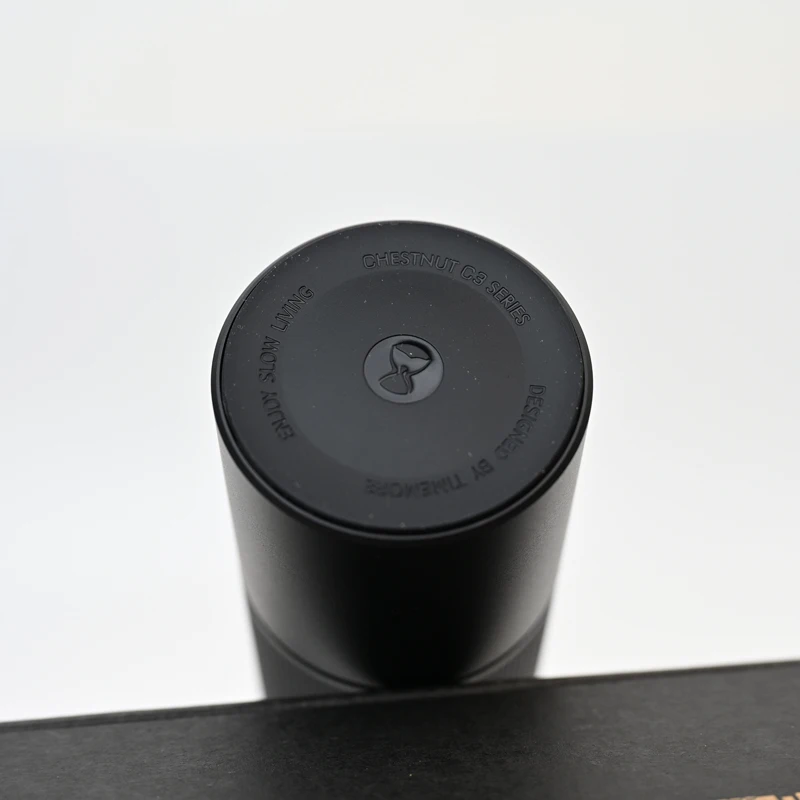
For countertop grinding, a wide, stable base prevents tipping and sliding, allowing you to focus on the grinding motion rather than stabilizing the unit. Some models feature non-slip feet or rings to enhance stability further.
Our all-metal hand grinder collection features several options designed with ergonomic handling as a priority, balancing durability with comfortable use.
Adjustment Mechanisms: Precision Without Pain
The grind adjustment system is where precision meets ergonomics. Even the most accurate adjustment mechanism loses value if it’s difficult or uncomfortable to use.
Accessibility is paramount—adjustment dials or knobs should be easy to reach and operate without awkward hand positioning. The best designs allow for adjustments without completely disassembling the grinder.
From an ergonomic standpoint, click adjustment systems offer distinct advantages over stepless designs. The tactile feedback of clicks provides confirmation of setting changes, especially helpful for those with reduced sensation in their fingers. Most quality click systems offer between 15-40 distinct settings, providing sufficient range for most brewing methods.
The force required to adjust settings varies significantly between models. Ideal designs require just enough resistance to prevent accidental changes but not so much that they cause strain or require tools to adjust.
Visual clarity matters too—clearly marked settings with high-contrast numbering help users confidently make adjustments without straining to see tiny markings or counting clicks from memory.
Common adjustment problems to watch for include:
- Dials that are too stiff or too loose
- Settings that drift during grinding
- Unclear markings or indicators
- Mechanisms that require awkward hand positions to operate
For those focusing on espresso preparation, understanding espresso grind settings for the perfect shot will help you appreciate the importance of an adjustment system that allows for both precision and comfort.
Workflow Efficiency: From Bean Loading to Grounds Collection
Ergonomics extends beyond the grinding action to encompass the entire workflow from loading beans to collecting grounds.
The bean loading experience starts with the hopper opening. An ideal design features:
- A wide mouth (1-1.5 inches in diameter) that minimizes spillage
- A slightly funneled edge that guides beans into the chamber
- A secure but easy-to-remove lid or cap
During grinding, stability is crucial. The grinder should remain firmly in place whether you’re holding it or it’s set on a countertop. Some models feature rubber bases or textured bottoms that prevent sliding during use.
The grounds receptacle should attach and detach with minimal effort, ideally using a simple twist motion or magnetic connection that doesn’t require fine motor skills or significant force. The connection should be secure enough to prevent accidental separation during grinding but not so tight that removal becomes a struggle.
Static buildup in coffee grounds can make handling messy and frustrating. Quality ergonomic grinders address this through:
- Metal grounds cups that reduce static compared to plastic
- Design features that minimize friction during grinding
- Smooth interior surfaces that allow complete emptying without tapping or banging
Cleaning accessibility is often overlooked but critically important for long-term ergonomics. Grinders designed with maintenance in mind feature easy disassembly without tiny parts or complicated reassembly procedures.
Our selection of handheld coffee grinders showcases models that excel in workflow efficiency while maintaining ergonomic comfort throughout the process.
Balancing Ergonomics with Grind Quality and Consistency
A truly great coffee grinder achieves both ergonomic excellence and superior grind quality—one shouldn’t come at the expense of the other.
Burr quality significantly impacts both the consistency of your grounds and the physical effort required. Sharp, precisely manufactured burrs cut beans more efficiently than dull or imprecise ones, reducing the force needed during grinding while improving particle size consistency.
Burr size creates an interesting ergonomic trade-off. Larger burrs (typically 48mm and above) grind more efficiently, requiring less time and effort, but result in bulkier grinders that might be less comfortable to hold. Smaller burrs (around 30mm) allow for more compact, lighter grinders but require more rotations and time to process the same amount of coffee.
Steel burrs generally require less initial force to begin cutting the beans compared to ceramic burrs, making them somewhat easier to use from an ergonomic perspective. However, ceramic burrs can maintain their sharpness longer, providing better long-term ergonomics with less degradation in performance.
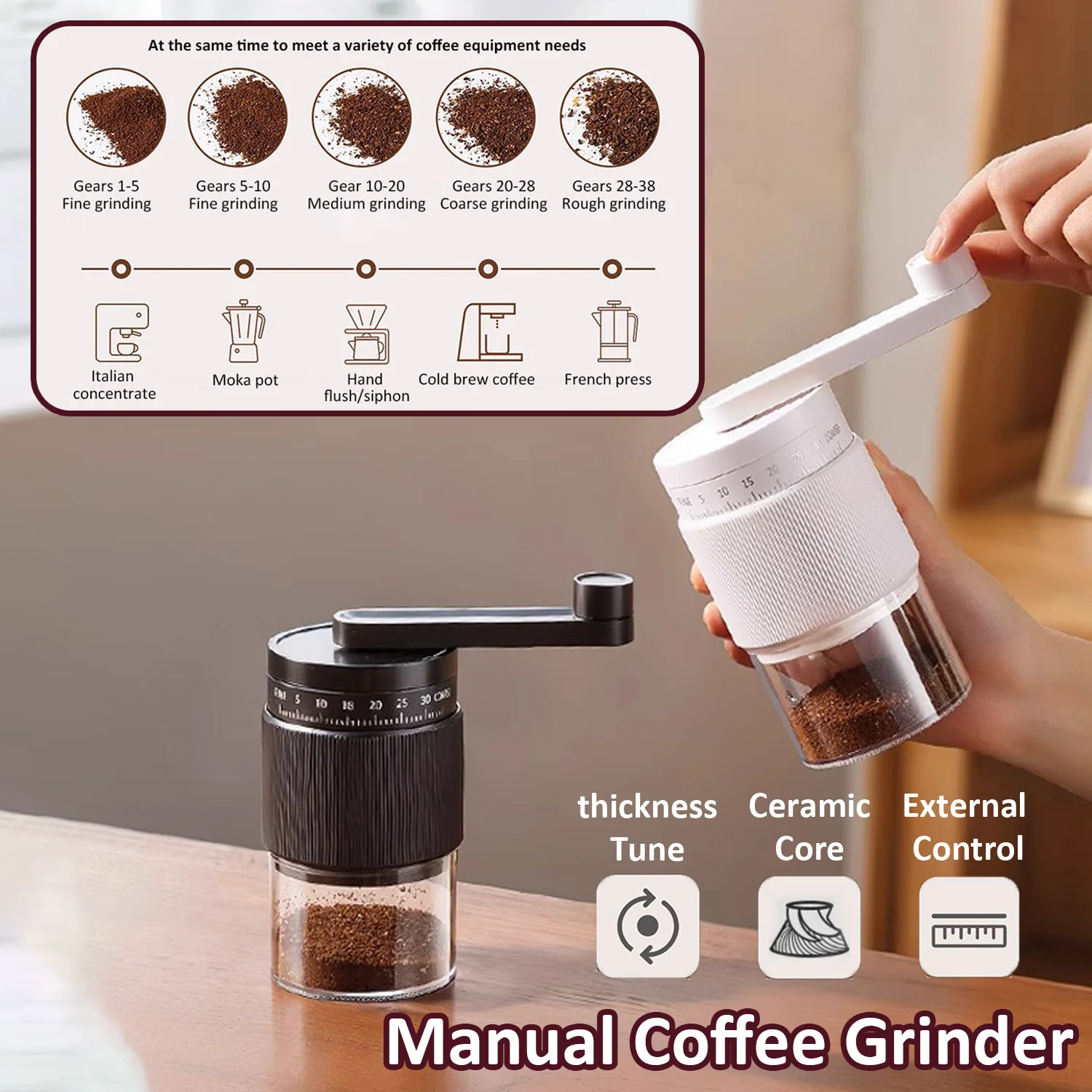
Grinder capacity also affects ergonomics. Larger capacity means fewer refills but adds weight and bulk. Most hand grinders strike a balance with capacities between 20-40 grams—enough for a few cups without becoming unwieldy.
Understanding how burr size affects coffee grind quality helps explain why certain design choices influence both the comfort of grinding and the quality of your coffee.
Hand Burr Grinder, Hand Crank Coffee Grinder, Manual Espresso Grinder, Portable Coffee Grinder
Price range: $262.72 through $300.22 Select options This product has multiple variants. The options may be chosen on the product pageHand Burr Grinder, Manual Coffee Grinder Stainless Steel, Precision Manual Grinder
Price range: $183.64 through $187.52 Select options This product has multiple variants. The options may be chosen on the product pageCeramic Burr Coffee Grinder, Hand Burr Grinder, Hand Crank Coffee Grinder, Manual Coffee Bean Grinder
Price range: $59.17 through $59.96 Select options This product has multiple variants. The options may be chosen on the product pageHand Crank Coffee Grinder, Manual Coffee Grinder for Espresso, Manual Coffee Grinder Stainless Steel
$349.15 Select options This product has multiple variants. The options may be chosen on the product page
How to Test Ergonomics Before You Buy: In-Store Experience
When possible, testing a coffee grinder in person provides invaluable insight into its ergonomic performance. Here’s a comprehensive testing procedure:
- Complete a full grinding cycle: Fill the hopper with beans and grind for at least 30-60 seconds continuously. This reveals issues that might not be apparent from just a few turns.
- Test with varying resistance: Adjust between fine and coarse settings to experience the range of effort required.
- Evaluate empty and full: Handle the grinder both empty and filled with beans to assess how weight affects comfort.
- Test stability: Place the grinder on different surfaces (wood, stone, plastic) to check for stability.
- Go through the full workflow: Load beans, grind, remove the collection cup, and simulate pouring into a brewing device.
- Try different hand positions: Attempt various grips to find comfortable options for extended grinding.
During testing, pay attention to:
* Any hotspots of pressure or discomfort in your hand
* Stability of the grinder during operation
* Smoothness of the grinding mechanism
* Ease of maintaining a consistent grinding pace
* How your wrist feels after 30+ seconds of continuous use
When speaking with sales representatives, ask specific questions about:
* Return policies if ergonomic issues develop after extended use
* Common feedback about comfort from other customers
* Recommended maintenance to maintain smooth operation
Exploring our hand burr grinder collection can provide options to test for ergonomic comfort that suits your specific needs and preferences.
Researching Ergonomics Online: What to Look For
When in-store testing isn’t possible, thorough online research becomes essential for evaluating ergonomics.
In product descriptions, look beyond marketing terms like “ergonomic design” for specific details:
* Exact handle length measurements
* Materials used for grip surfaces
* Weight and dimensions
* Bearing types mentioned
* Any specific ergonomic features highlighted
User reviews provide real-world ergonomic assessments. Pay special attention to:
* Comments mentioning extended use comfort
* References to specific hand sizes or strength levels
* Mentions of fatigue or strain after grinding
* Comparisons to other models the reviewer has used
* Reports of issues developing over time
Photos and videos reveal ergonomic details that specifications might miss:
* How users actually hold the grinder during operation
* The natural positioning of hands and wrists
* Stability during grinding
* Size relative to common objects
Red flags in reviews that suggest potential ergonomic issues include:
* Repeated mentions of hand fatigue
* Comments about beans getting stuck
* Reports of unstable or wobbling handles
* Complaints about difficult adjustments
* References to cramping or discomfort
For travel needs, examining our portable coffee grinder options can help identify models that balance ergonomic design with portability.
Top Ergonomic Manual Coffee Grinders: Recommendations By Category
Based on ergonomic design excellence, here are recommendations across different categories:
Best Overall Ergonomic Design
- Key features: Balanced weight distribution, smooth ball-bearing mechanism, comfortable wooden knob handle, 38mm steel burrs
- Best for: Daily coffee enthusiasts who value comfort and precision equally
- Ergonomic strengths: Minimal wrist strain during extended grinding, stable base, easy adjustment
Best for Smaller Hands or Limited Strength
- Key features: Compact body design (2-2.5 inches diameter), shorter crank with excellent leverage, lightweight (8-10 ounces), textured grip surface
- Best for: Users with smaller hands, those with arthritis or limited grip strength
- Ergonomic strengths: Requires less force to operate, easier to hold securely, well-balanced for stability
Best for Travel with Ergonomic Considerations
- Key features: Collapsible handle, protective case, lightweight yet stable design, compact size without sacrificing grip comfort
- Best for: Frequent travelers who don’t want to sacrifice comfort for portability
- Ergonomic strengths: Maintains good leverage despite compact design, comfortable for daily use on the road
Best Value Ergonomic Options
- Key features: Quality bearings, comfortable grip materials, stable base design at mid-range price points
- Best for: Budget-conscious buyers who prioritize comfort but have spending limits
- Ergonomic strengths: Good balance of ergonomic features while minimizing costs in non-essential areas
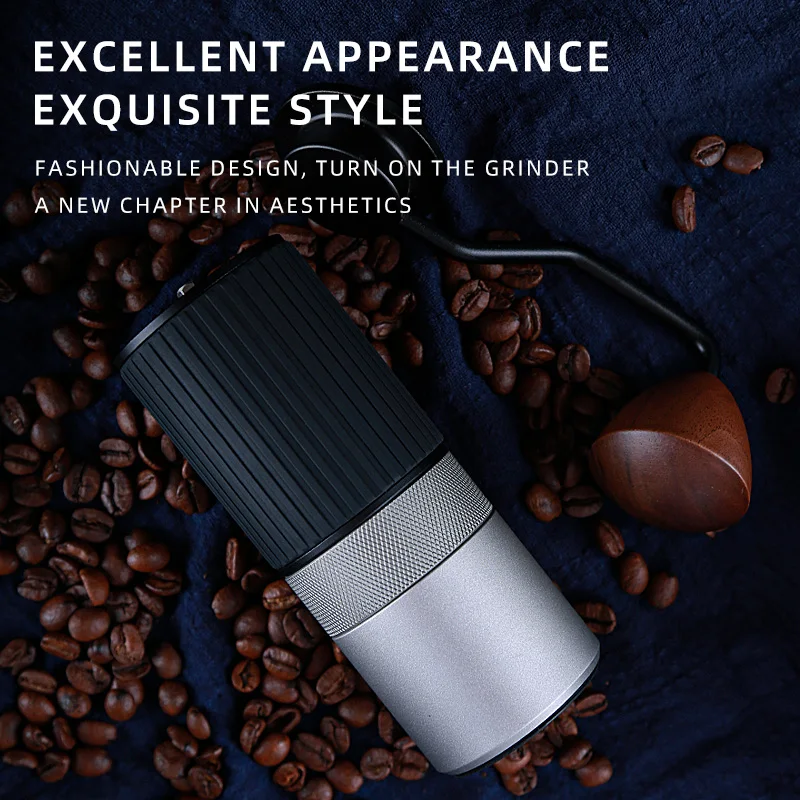
Exceptional Handle and Crank Design
- Key features: Premium bearing systems, perfectly balanced crank length, ergonomically shaped handles
- Best for: Those who grind larger volumes or finer grinds regularly
- Ergonomic strengths: Minimizes effort required through mechanical advantage, prevents fatigue during extended use
Explore our manual coffee grinder for espresso collection for options specifically designed to handle the resistance of fine grinding with ergonomic comfort.
Finding Your Ergonomic Match: Different Brewing Methods
Different brewing methods place different demands on your grinder and, consequently, on your body. Matching your grinder’s ergonomic features to your preferred brewing method enhances both comfort and results.
Espresso Grinding
Espresso requires the finest grind settings, which create the most resistance during grinding. For espresso enthusiasts:
* Look for longer handles that provide maximum leverage
* Premium bearing systems become essential, not optional
* Stability during high-resistance grinding is crucial
* Comfortable grip materials help manage the additional force required
Pour-over Brewing
Medium grinds for pour-over methods strike a balance:
* Focus on grinders that maintain consistency at medium settings
* Comfortable operation for 30-45 seconds of grinding
* Good grip for the moderate force required
* Precise adjustment mechanisms for dialing in the perfect flow rate
French Press
Coarse grinding for French press is generally easier on your hands:
* Less resistance means ergonomics can focus on speed and comfort
* Larger burrs process beans more quickly for coarse settings
* Grip stability still matters for consistent results
* Look for grinders that excel at producing uniform coarse particles
Understanding the ultimate espresso grind size chart helps connect your ergonomic needs with the technical requirements of your preferred brewing method.
The Long-Term Value of Ergonomic Design: Beyond Initial Comfort
Investing in an ergonomic coffee grinder delivers benefits that extend far beyond your first few uses:
A comfortable grinder sustains your coffee ritual over years, not just months. Many coffee enthusiasts who begin with inexpensive, poorly designed grinders eventually abandon hand grinding altogether, missing out on the quality benefits of freshly ground beans.
Ergonomic design prevents the development of repetitive strain issues that might not be apparent initially but can emerge after months of daily use. These problems can be difficult to reverse once established.
Quality ergonomic grinders also typically feature better overall construction, meaning your investment in comfort often translates to durability. Many premium manual grinders last 5-10+ years with proper care, making their cost per use remarkably low.
Consider the “enthusiasm test”—will you still enjoy using your grinder after the novelty wears off? Ergonomic features often determine whether manual grinding becomes a cherished ritual or an abandoned effort.
The ergonomic features in coffee grinders that provide the best long-term value typically include quality bearings, durable handle attachments, and materials that maintain their comfort properties over time.
Is an Ergonomic Manual Grinder Right for You? Honest Considerations
While ergonomic manual grinders offer many benefits, they’re not the perfect solution for everyone. Consider these questions:
How much coffee do you prepare daily?
For single cups or small batches, a manual grinder works beautifully. If you regularly prepare coffee for large groups, the physical effort might become prohibitive regardless of ergonomics.
Do you have existing hand or wrist issues?
Even the most ergonomic manual grinders require some physical effort. Those with significant arthritis, carpal tunnel syndrome, or other hand limitations might be better served by electric options.
What’s your budget reality?
Quality ergonomic features typically add cost. While these investments pay dividends in comfort and longevity, budget constraints are real considerations.
Do you value the ritual or the result more?
Manual grinding creates a meaningful connection to your coffee preparation. If you’re more focused on convenience than experience, an electric grinder might better serve your needs.
How important is portability?
Manual grinders excel for travel, camping, and off-grid situations. If you never travel with your coffee setup, this advantage may be less relevant.
What’s your noise sensitivity?
Manual grinders operate almost silently—a significant advantage for early risers in shared living spaces or parents with sleeping children.
By carefully considering these factors alongside the ergonomic features discussed throughout this guide, you’ll be well-equipped to choose a manual coffee grinder that provides both comfort and quality for your personal brewing journey.

